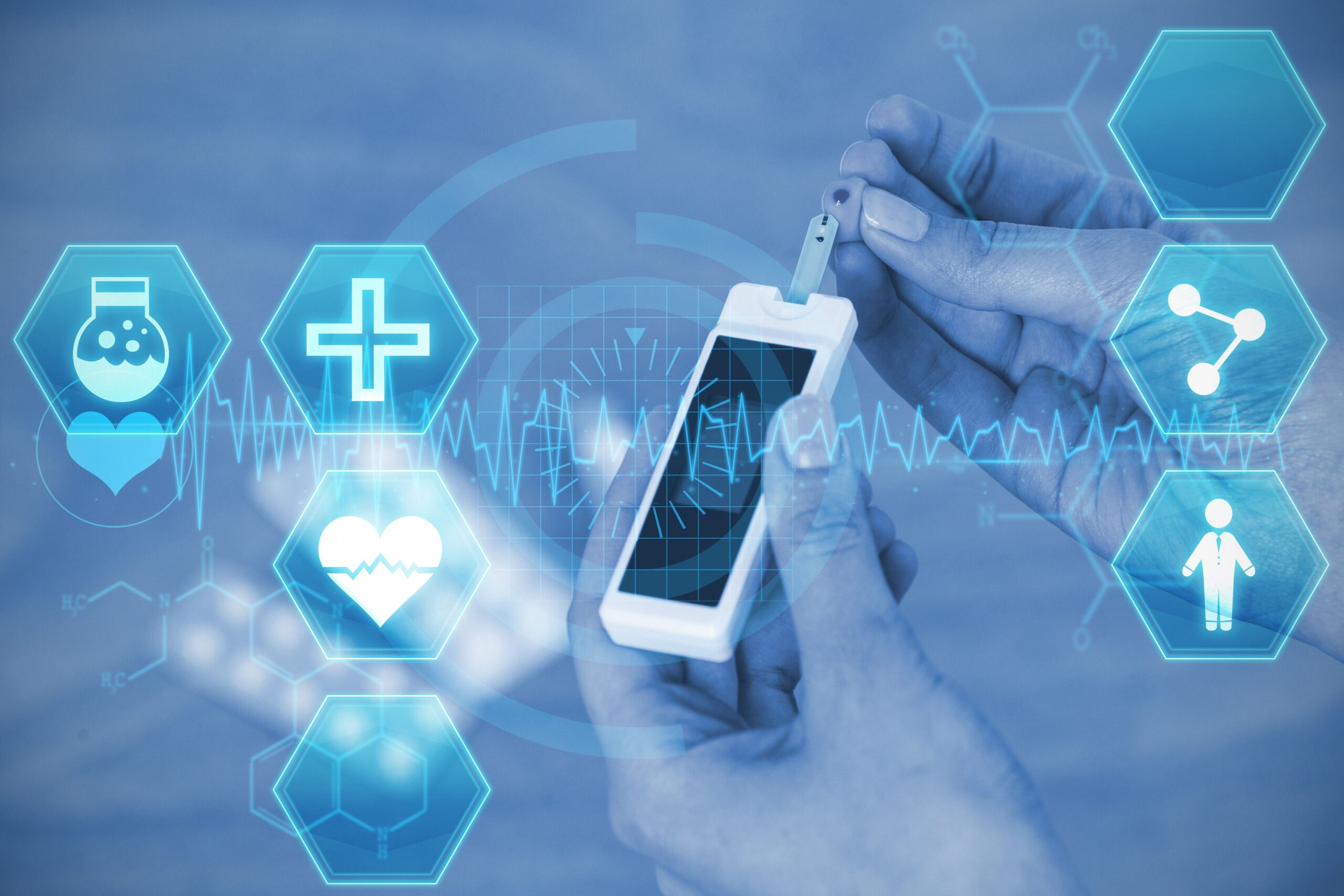Collaboration between stakeholders in the diabetes technology space is necessary to generate new standards of evidence that keep pace with product innovation, according to findings of an editorial published in the Journal of Diabetes Science and Technology.1
Blood glucose monitor surrounded by health care icons / vectorfusionart – stock.adobe.com

Advancements in diabetes technology are happening so rapidly that traditional evaluation methods struggle to keep up with assessing their safety and effectiveness. This challenge arises amidst a growing demand for these products, with an estimated 350,000 and 2.4 million people with diabetes using insulin pumps and continuous glucose monitors (CGMs) as of 2021, respectively.2,3 With the global number of diabetes cases expected to rise, the need for efficient and reliable methods to evaluate these technologies is only getting larger.
Key Takeaways
- Diabetes technology is rapidly evolving, but traditional ways of assessing safety and effectiveness struggle to keep pace with advancements.
- Current research methods in diabetes technology present a trade-off between getting new technologies to patients quickly and ensuring they are safe and effective.
- The authors call for collaboration between researchers, regulators, manufacturers, and patients to develop new evaluation methods that sustain the pace of innovation and demand of patients in the diabetes technology space.
According to investigators of the current study, this clash between innovation and regulation creates a Catch-22 dilemma: when it comes to launching new diabetes technology, “either the evaluation lags behind the developing technologies or diabetes technologies are used without sufficient evaluation.”1
Both outcomes pose problems for people with diabetes who rely on tools such as CGMs, pumps or pens for insulin administration, and digital therapeutics, to manage their condition. The current review explores ways to adapt evaluation methods for diabetes technology to accelerate access for patients without compromising safety or effectiveness.
Evidence for diabetes technology is necessary for 3 reasons: it helps to ensure that products are safe and effective for patients, helps payers, such as health insurance companies, decide whether to reimburse the costs, and helps the products gain initial market clearance.
READ MORE: Insulin App Recall Prompts FDA Warning After More Than 200 Reported Injuries
However, various issues arise when it comes to generating this evidence, such as a lack of protocol on managing upgrades in software and hardware.1 Although software is easy to update from a developer perspective, regulatory approval is necessary for any modifications that could impact safety or effectiveness. When it comes to hardware, the distinction between a minor update and a major revision requiring a new clinical evaluation remains undefined.
Diabetes technology undergoes rigorous product reviews and testing before initial market clearance. However, the constant need for upgrades to keep pace with innovation in the field raises questions about the amount of ongoing evidence needed for subsequent regulatory approvals, especially as conducting this research can be time- and resource-consuming.
“From the decision to perform such a clinical study to the availability of the study results and publication of these results, it easily takes several years,” wrote investigators. “Do the results obtained with 1 generation of a medical product, for example, a given CGM system, also hold true for the next generation of this product, which might have some significantly different features?”
Some companies circumvent regulatory restrictions by bringing diabetes technology to market that does not adhere to compliance standards, supported by a patient desire for unfettered access1 to the products. Despite concerns about safety and effectiveness, the demand for faster access has led regulatory bodies to grant conditional approval to some technologies even if they lack full clearance.
“If your pockets are deep enough to pay many lawyers for several years and the financial benefits from doing so are so big, that this counterbalances the costs for legal battles, then this might be an illegal and unethical approach that works,” wrote authors.
Further driven by the demand for access to diabetes technology, people with diabetes have also begun developing their own automated insulin delivery systems, often referred to as “do-it-yourself” (DIY) systems. A recent example is the Loop algorithm, which evolved from a DIY solution to an FDA-approved commercial product upon gaining approval early last year.4
The current landscape of diabetes technology research involves trade-offs between speed and certainty. While randomized controlled trials (RCTs) are the gold standard for ensuring high quality data, their high cost and lengthy timelines can delay innovation. Whereas real-world data provides evidence quickly due to its accessibility, results can be less reliable than RCTs due to potential biases.1
Since diabetes technology innovation, combined with strong patient demand, has outpaced current evaluation methods, the authors call for new approaches that “keep up with the times.”1 These new approaches, they emphasize, should balance the speed and reliability of evidence gathering and leverage the expertise of stakeholders to satisfy the needs of those who rely on the products.
“We believe that [an agreement among scientists, regulators, manufacturers, and people with diabetes about which standards of evidence are appropriate for which innovations in diabetes technology] can accelerate market access for new diabetes technologies by avoiding unnecessary evidence requirements for the evaluation of updated technologies, thereby reducing costs,” concluded investigators. “At the same time, such an agreement can also help to provide important evidence of the efficacy, safety, and usability of new diabetes technologies for people with diabetes, health care professionals, scientists, regulatory bodies, and health insurance companies.”
READ MORE: Continuous Glucose Monitoring Resource Center
Are you ready to elevate your pharmacy practice? Sign up today for our free Drug Topics newsletter and get the latest drug information, industry trends, and patient care tips, straight to your inbox.
